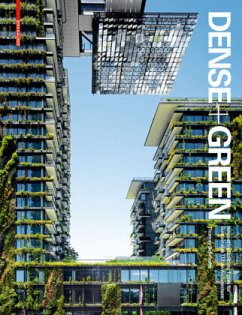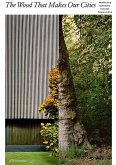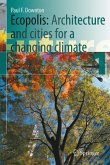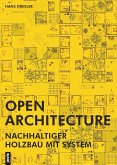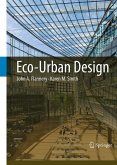The integration of nature in architecture is a key concern of sustainability. However, all too often sustainable design is reduced to improving the energetic performance of buildings and the ornamental application of natural green. Dense + Green explores new architectural typologies that emerge from the integration of green components such as sky terraces, vertical parks and green facades, in high-density buildings.
The book describes green strategies in a comparison across different design tasks and climate conditions. In-depth case studies on the most relevant building types, consistently presented with analytical drawings made exclusively for this book, are complemented by expert essays that demonstrate the current paradigm shift in the sustainable urban environment.
From the Contents:
•Dense + Green Building Types, by Thomas Schröpfer, architect, Singapore University of Technology and Design
•Dense + Green Building Technology, by Atelier Ten, environmental design consultants and building services engineers, New York, NY
•Dense + Green Landscape Design, by Herbert Dreiseitl, landscape architect, Atelier Dreiseitl/Rambøll Liveable Cities Lab, Überlingen/Singapore/Portland, OR
•Dense + Green Botanical Design, by Jean Yong, plant eco-physiologist, Singapore University of Technology and Design
•Dense + Green Urbanism, by Kees Christiaanse, urban planner, ETH Zurich
•25 in-depth case studies from Europe, Asia and the USA
•Practice Reports by Foster + Partners, WOHA, Ken Yeang, MVRDV and others
Entwerfen und Konstruieren mit organischen Materialien ist ein wichtiger Bestandteil des nachhaltigen Bauens. Allzuoft wird Nachhaltigkeit auf Bautechnologie reduziert, und das Grün hat nur ornamentale Funktion. Dense + Green stellt Innovationen bei hochverdichteten Bautypen dar, die aus dem umfassenden Einsatz von grünen Komponenten wie vertikalen Gärten und begrünten Fassaden hervorgehen.
Das Buch beschreibt detailliert Strategien für eine große Zahl von Bauaufgaben und grünen Baubereichen unter unterschiedlichen klimatischen Voraussetzungen. Ausgeführte Beispiele für wichtige Bautypen werden mit durchgängig neu angefertigten Zeichnungen dargestellt und analysiert. Ein Team von international renommierten Autoren legt den aktuellen Wandel im Bauen für nachhaltige städtische Umgebungen dar.
Aus dem Inhalt:
Hochverdichtete grüne Bautypologien, von Thomas Schröpfer, Architekt, Singapore University of Technology and Design
Bautechnologien für hochverdichtete grüne Bereiche, von Atelier Ten, Umwelt- und Bautechnikingenieure, New York
Landschaftsarchitektonische Aspekte, von Herbert Dreiseitl, Atelier Dreiseitl/Rambøll Liveable Cities Lab, Überlingen/Singapur/Portland
Botanische Aspekte, von Jean Yong, Ökophysiologe, Singapore University of Technology and Design
Städtebau mit hochverdichteten grünen Bautypen, von Kees Christiaanse, Stadtplaner, ETH Zürich
Analyse von 25 Bauten aus Europe, Asien und USA
Praxisberichte von Foster + Partners, WOHA, Ken Yeang, MVRDV und anderen Architekten
The book describes green strategies in a comparison across different design tasks and climate conditions. In-depth case studies on the most relevant building types, consistently presented with analytical drawings made exclusively for this book, are complemented by expert essays that demonstrate the current paradigm shift in the sustainable urban environment.
From the Contents:
•Dense + Green Building Types, by Thomas Schröpfer, architect, Singapore University of Technology and Design
•Dense + Green Building Technology, by Atelier Ten, environmental design consultants and building services engineers, New York, NY
•Dense + Green Landscape Design, by Herbert Dreiseitl, landscape architect, Atelier Dreiseitl/Rambøll Liveable Cities Lab, Überlingen/Singapore/Portland, OR
•Dense + Green Botanical Design, by Jean Yong, plant eco-physiologist, Singapore University of Technology and Design
•Dense + Green Urbanism, by Kees Christiaanse, urban planner, ETH Zurich
•25 in-depth case studies from Europe, Asia and the USA
•Practice Reports by Foster + Partners, WOHA, Ken Yeang, MVRDV and others
Entwerfen und Konstruieren mit organischen Materialien ist ein wichtiger Bestandteil des nachhaltigen Bauens. Allzuoft wird Nachhaltigkeit auf Bautechnologie reduziert, und das Grün hat nur ornamentale Funktion. Dense + Green stellt Innovationen bei hochverdichteten Bautypen dar, die aus dem umfassenden Einsatz von grünen Komponenten wie vertikalen Gärten und begrünten Fassaden hervorgehen.
Das Buch beschreibt detailliert Strategien für eine große Zahl von Bauaufgaben und grünen Baubereichen unter unterschiedlichen klimatischen Voraussetzungen. Ausgeführte Beispiele für wichtige Bautypen werden mit durchgängig neu angefertigten Zeichnungen dargestellt und analysiert. Ein Team von international renommierten Autoren legt den aktuellen Wandel im Bauen für nachhaltige städtische Umgebungen dar.
Aus dem Inhalt:
Hochverdichtete grüne Bautypologien, von Thomas Schröpfer, Architekt, Singapore University of Technology and Design
Bautechnologien für hochverdichtete grüne Bereiche, von Atelier Ten, Umwelt- und Bautechnikingenieure, New York
Landschaftsarchitektonische Aspekte, von Herbert Dreiseitl, Atelier Dreiseitl/Rambøll Liveable Cities Lab, Überlingen/Singapur/Portland
Botanische Aspekte, von Jean Yong, Ökophysiologe, Singapore University of Technology and Design
Städtebau mit hochverdichteten grünen Bautypen, von Kees Christiaanse, Stadtplaner, ETH Zürich
Analyse von 25 Bauten aus Europe, Asien und USA
Praxisberichte von Foster + Partners, WOHA, Ken Yeang, MVRDV und anderen Architekten

